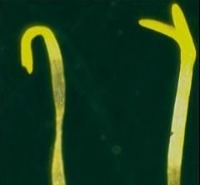
Features
Lighting
Structures & Equipment
Researching plant growth achieved without light
May 17, 2012 By Karlsruhe Institute of Technology
May 17, 2012, Baden-Württemberg, Germany — Plants are dependent on the
sun. Sunlight does not only supply them with energy, but also controls
their development steps.
May 17, 2012, Baden-Württemberg, Germany — Plants are dependent on the sun. Sunlight does not only supply them with energy, but also controls their development steps.
So-called photoreceptors activate the processes of germination, leaf development, bud formation, and blossoming in the cells. The light-absorbing component of a photoreceptor may be replaced by a chemically similar synthetic substance. For the first time, the effects on complete plants are now described in the The Plant Cell journal (DOI: 10.1105/tpc.111.094656).
“The plants developed in the dark as if they were in light,” says the director of the studies, Tilman Lamparter, of the Karlsruhe Institute of Technology (KIT).

|
| The seedling on the right was fed with a synthetic photoreceptor and opens its cotyledons. In the dark control (left seedling), they remain closed. (Figure: T. Lamparter, KIT) |
The seeds and seedlings of thale cress were fed with a synthetic substance named “15Ea-phycocyanobilin." In the plant cell, this substance replaces the natural, photoactive component of the photoreceptor, the “phytochromobilin."
Incorporation of 15Ea-PCB activates the photoreceptor and the plant is made to believe it is exposed to light. In spite of the darkness, model plants germinate and grow similar to a control group exposed to light.
“It was shown for the first time that synthetic substances can cause light effects in entire plants.”
Synthetic photoreceptors might be valuable tools for research, as they facilitate studies of many chemical plant processes compared to conventional genetic engineering methods. Apart from growth, photosynthesis can also be investigated much better.
“Blossoming of flowers or development of the photosynthesis system may be controlled much better in the future,” predicts Lamparter. “These findings would be of high use for agricultural industry in the cultivation of flowers or biomass production, for instance.”
In the future, it is planned to study related aspects in further detail.
Print this page